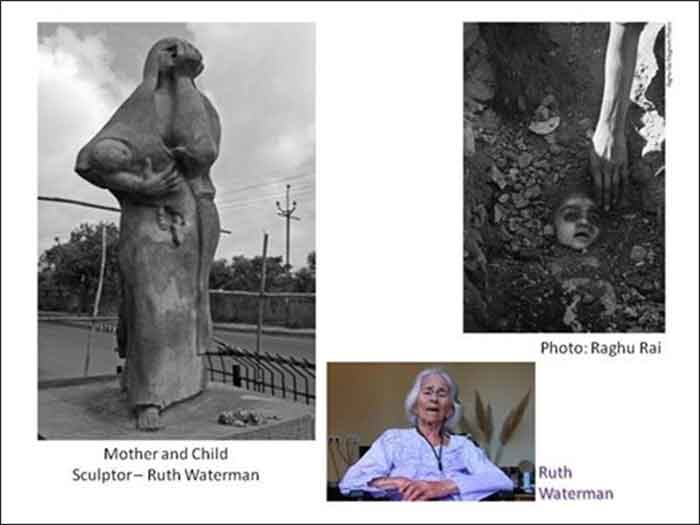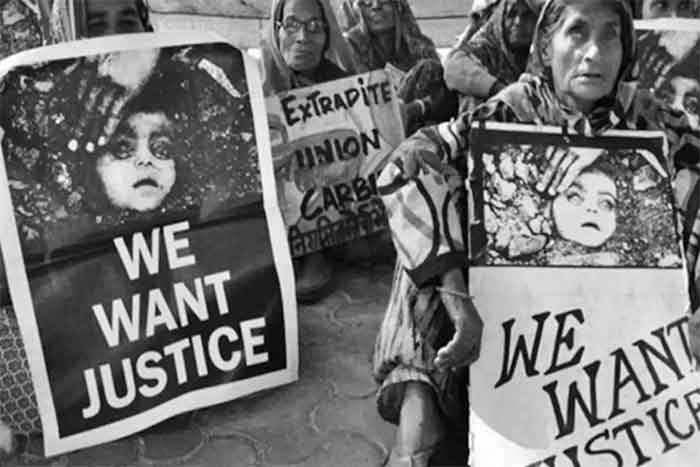From the Bhopal disaster to a song in raaga Bhopali, through some photos and stories…

Do you know Marshal? Aatank? Kavin? Aayudh? No? Just names of four out of so many pesticides, herbicides made of carbamate chemicals H2COO⁻ and carbamates are made from an intermediary chemical named Methyl Isocyanate, CH3NCO. And Methyl isocyanate was manufactured and stored factories like Union Carbide, Bhopal, where a little mishap, like a gas leaked out and got in touch with a little rain water (it did rain a few days earlier) exploded a whole tank of chemical, and then a killer gas creeped out and enveloped shanties and slums and homes in a winter night and killed thousands. That night of December 2-3, 1984.
Those thousands never visited any 5-star hotel in a thriving rich Metro City, neither did they saw skyscrapers, nor were they killed by some ‘Islamic Terrorists’, and no candle marches, vigils, no 9-11 like memorials. And no arrests. After all, they were Sahibs, Americans. And one of India’s most praised, celebrated philanthropic capitalists pleaded to govt of India to withdraw cases against that company so that the company might get absolved from paying “clean up costs”! Sssssh – aap Tata ka nimak khaya hai, na!

But that is just one part of the picture. On the other part, there are you, and millions of toilers on our lands who are producing materials for our anna and bastra, food, textiles. Nobody told them the danger rather fooled them in the name of “Green revolution” “Science and Technology”. We invited home the silent killers.

But even if there was no Islamic terrorist involved there was an angel like human. He was Abdul Jabbar. The world knows him as the most tireless and devoted fighter for the victims of world’s biggest industrial accident.

He lost his mother, father and elder brother in the gas-disaster. His own lungs got much damaged. His vision was lost by almost half. But his fight continued. A few paragraphs will not be able to tell who was Abdul Jabbar ad how he managed to do all he did. He did not pray to any government or NGO or anybody for his own treatment, perhaps a better treatment could decrease the pain he had in in last days in the hospital. All through his fight he kept distance from the capitalists, governments and their philanthropy with contempt, and also from philanthropic religious organisations. There was a report that when Digvijay Singh heard the gravity of his illness he rushed an air-helicopter to send him to Mumbai, but it was already late, perhaps by some minutes or hours. Anyway, the Govt of India awarded him Padmasree posthumously in 2020. For people in power a dead Abdul Jabbar was easy and safe to handle.
Abdul Jabbar was a nobody, just a child of a poor family, worked in construction as a borewell digger or perhaps a hand-pump mechanic also. He had no academic credentials to show. And he showed what a nobody can do, how stubbornly and persistently a nobody can fight. Just like those lakhs or millions of farmers who are fighting he govt camping more than a year on the roads around the capital.
At the top of the article there is a picture. It shows a lady, Ruth Waterman. Ruth lost all of her family in Hitler’s Gas Chamber but she escaped death somehow miraculously. She was raised in The Netherlands. She wanted to do something for this Gas Chamber City, Bhopal. She contacted some friends in Delhi’s Lalit Kala Academy and came to Delhi to make a sculpture there. After it was built there was a problem. What if the govt stops them and takes away the art piece! Her friends devised a way. It was smuggled into Bhopal under sand in a sand carrying truck by her friends at Lalit Kala Academy and at the dark of night it was put just by the side of the Union Carbide factory.
Ruth’s son once sent a letter to Partha Maitra of Times of India. Part of it was published in Times of India on Dec 4, 2014. Let us read a part of that letter, it is also a ruthless criticism to us who swallow things as inevitable. “Towards the end of her life, my mother, Ruth Waterman Kupferschmidt, developed symptoms of Parkinson’s disease. She began receiving medication and for many years continued to live an independent life. Her identification with people of Bhopal and the disaster that unfolded there remained very strong. Unfortunately, her personal life story and her feelings about Bhopal were sometimes confused. Emotionally, and on an ethical level, this confusion seems both inevitable and logical. My grandparents were transported to the Auschwitz concentration camp and gassed. The political ideology and technology that led to the death of my grandparents is in many respects the same that puts profit before people today. So aside from the deep sense of empathy my mother felt for the people of Bhopal, there is a sense in which my mother’s failure to distinguish between innocent victims of Nazis and victims of the Bhopal gas disaster transcends the superficial and points to a more timeless ethical principle. The very principle that is violated by those who would have us believe these events are unconnected. As we all know, DOW chemical produced the Agent Orange that was used indiscriminately above forests and cities of North Vietnam. War, ruthless profiteering and victims among the earth most vulnerable people are all part of a larger systemic problem. Bringing those responsible to justice is important, but it is even more important that the systems that permit and encourage such abuses are exposed. By delaying justice to victims of Bhopal, the Indian government and courts have implicated themselves very seriously in the commitment of these injustices. We can only hope the government will one day take a stand for victims, but I am sure my mother would agree it is better not to wait for them to do so. …
At this time, my thoughts go out to people of Bhopal, to my friends there and to all those people whose lives are intertwined with my mother’s when she was there building the monument. I am sure my mother would have continued to travel to Bhopal if her health had permitted. She would have wanted to join in the commemoration, but above all, she would have wanted to spend time with the young people whom she met when they were still just children. We wish them all love, light and courage.”
Such people like Abdul Jabbar, Ruth Waterman are not few in number. On November 7, 1967, Dow Chemicals came for campus recruitment drive at MIT. Yes, that MIT, the supposedly No. 1 Tech Campus in world saw a student protest- students of MIT assembled to stop DOW and even 7 of the 15 selected for interview were ready to stage protest inside the interview room.

From Vietnam to Bhopal, and to the river Beas or Bengal, the claws of the imperialists left their mark d still there. The screenshot given below is todays. In “Socialist” or “Communist” Vietnam there is ttps://vn.dow.com/en-us.html DOW made Agent Orange which is a mixture of two herbicides which farmers spray o get rid of unwanted herbs. [The active ingredient of Agent Orange was an equal mixture of two phenoxy herbicides – 2,4-dichlorophenoxyacetic acid (2,4-D) and 2,4,5-trichlorophenoxyacetic acid (2,4,5-T) – in iso-octyl ester form.] The US military sprayed an equivalent of 30 Olympic Size Swimming Pool full of herbicides in Vietnam to destroy rice and other crops so that Vietnamese Red Power bases and Guerrillas starve to die. After all rice-paddy, wheat, these are also kind of herbs, loosely speaking. But see how gentle our “communists” are. They allow yesterday’s killers to help in Growth, in GDP and in so many important things, much more important than the memory of our ancestors.

We are in a “practical” world. We learn living with everybody, we adjust.

Bhopal is associated with the name of a raga – Bhopali. Long long ago, for a 1963 movie in Assamese, Bhupen Hazarika wrote a song in this raga. Buk hum hum kare. The film was regarding Maniram Dewan a famous freedom fighter. Later he used the same tune for a 1992-93 hit song Buk Hoom Hoom Kare for the film Rudali. But the Assamese lyric was different. A rough translation could be obtained from a website. Let us commemorate Bhopal with this song this year…. I will make bring solace, mukti-prabhat for my mother(land) shedding my blood Jaasim xaantona aai mukti pronbhaatere / I will bring solace to you O’ mother with freedom of early dawn / Paatim thaapona / Aair xunit piahere – sang Bhupen Hazarika.

Buku hom hom kore mur aai..
[ _My mother….(Asom)….my heart weeps ��for you]_
Kune nidra hore mur aai _..[What has stolen my sleep.my mother… (Asom)..?]_
Putra hoi moi ki mote toru..
{ _Being a son, how do I free you from this misery..}_
Aai ture hoi moi moru _!
{I die for you mother.. worrying��..}
Buku hom hom kare mur aai..
Dexore sandroma kaal endhaare awore..
{ _The full moon �� of my country Asom is shrouded by Kaalratri darkness��}_
NB.. British occupation
Ogoni kaalika dehor rondhe rondhe sore..
{ _Fire like Kalika is running through every vessel in my body}_
Buku hom hom kare mur aai..
Bojra Xamadriho aai…
Soupahore garh…
{..The ramparts on all sides stands firm like Vajra}_
Soupaxore garh bhedi kinsitu naai poth..{ _There’s no way enemy (British) can find a way through the ramparts}_
Jaasim xaantona aai mukti pronbhaatere..
{I will bring solace to you O’ mother (Asom) with freedom of early dawn_ ����}
Paatim thaapona..
Aair xunit piahere..
{ _I will establish a Guru Asana for you with my blood}_
http://allaboutassameselyrics.blogspot.com/2011/04/buku-hum-hum-assamese-lyrics-by-bhupen.html
Sandeep Banerjee is an activist who writes on political and socioeconomic issues and also on environmental issues. Some of his articles are published in Frontier Weekly. He lives in West Bengal, India. Presently he is a research worker. He can be reached at [email protected]












































